

















If you think this issue is looking a bit thin, or there’s something you would like to write about? Then we want to hear from you. This newsletter is only as good as the contributions put in to it.



















If you think this issue is looking a bit thin, or there’s something you would like to write about? Then we want to hear from you. This newsletter is only as good as the contributions put in to it.
Suffolk Wildlife Trust has scheduled several courses at its nature reserves over the coming months, such as:
Introduction to Hedgehogs, with Paula Baker at Carlton Marshes on October 16
Winter Bird ID, with Paul Holness at Lackford Lakes on Sunday December 4
You can find details of all of the Trust’s courses for adults via this link:
www.suffolkwildlifetrust.org/wildlearning
The new schedule of Wildlife Live Webinars begins again in the Autumn with topics such as:
The Magic of Nests with Nicolae Coe on Wednesday evening, November 2
Slugs with Ian Bedford on Monday evening, November 28 As well as Wader ID, with Chris Mills,
Planting for Pollinators with Sonya Burrows and Native hedgerows with Helen Bynum yet to have dates confirmed
To find details of all the Trust’s Wildlife Live Webinars, just follow this link:
https://www.suffolkwildlifetrust.org/wildlife-live-webinars
For any questions or course suggestions, please contact wildlearning@suffolkwildlifetrust.org
Hope you’re all safe and well. I would like to thank all the well wishers who commented on my first issue as editor, I’m glad you liked it. However, I must extend that thanks to all the contributors too, for whom without, there would be no newsletter. So, a big thank you to all our contributors.

Last issue, I asked for articles and you did not disappoint. So many articles came in of such good quality that I haven’t had quite enough room for them all, so do not worry if your article isn’t in this issue, it is sitting in the wings waiting for the next issue. Just a note for those of you who would like to contribute, if possible, can you please include some separate photos with your article. Including photos within your text is rather problematic when it comes to separating them. If you don’t have any photos, not to worry, just let me know and I’m sure some of our wonderful members, through the power of Facebook, will be happy to contribute just as they did for an article by Anne Kell in this issue. Well done everyone who sent in photos and thank you.
At last, we can all meet in person again at the members evening on 24th November at Bentley Village Hall and I hope to meet some of you there. See details on page 11.
Till then, I hope you enjoy this issue and if I do not see any of you before Christmas (yes, that came round quick, didn’t it?), I wish you all a happy one.
I’m sure many people at the start of lockdown wondered what they were going to do with themselves. I decided that I was going to make an inventory of all the flora and fauna in the garden.
About 10 years ago soon after moving to Lawshall, a village south of Bury St Edmunds, we purchased some farmland attached to the garden. I quickly decided that I wanted to re-wild this land and therefore it made sense to determine what flora and fauna is out there and how this changes over the years. I was therefore very quickly on a very steep and wide learning curve. Previously I had some knowledge of birds and a few butterflies but that was it.
I purchased lots of books and joined many Facebook groups hoping that there were experts out there willing to help me. I soon realised that one of the most helpful sites was that of the UK Hoverflies group. The admin of this group work tirelessly to identify any posts and as long as you were able to record or provide a grid reference for sightings, they are very pleased to help. The aim of the group is not only to obtain recording information for Hoverflies, but to educate and enthuse members of the group.
Not only was I on a steep learning curve trying to identify all the insects in my garden but I quickly found out that unless I could obtain a reasonable photo, identification help could be limited. Hoverflies form the family Syrphidae which have an additional spurious vein in the wing surface.

Chrysotoxum bicinctum on the left is one of the many distinctive wasp mimics which is easy to identify in the field.
This one is male, it’s fairly easy to tell males and females apart. Like all other flies the males have bigger eyes which come closer together at the top of the head. Females have much smaller eyes, placed farther apart.
One of the joys of learning hoverflies is that there are only 281 species usually with black and yellow markings, so identification is easier to learn than some insects. In addition very few need to have genitalia dissected. They are important pollinators and easy to see in most open habitats.
Another group of large distinctive hoverflies belong to the genus Volucella. This group only has 5 species. The Great Pied Hoverfly (Volucella pellucens) is one of the commonest and is often seen on bramble and umbellifers between May and October.
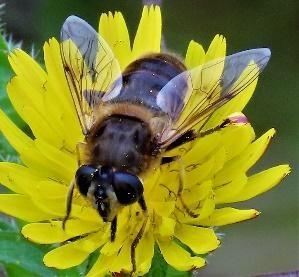
Left: One of the largest and commonest hoverflies is the Drone Fly or Eristalis tenax, and this can be found all year round.
One of the joys of learning hoverflies is that there are only 281 species usually with black and yellow markings, so identification is easier to learn than some insects. In addition very few need to have genitalia dissected. They are important pollinators and easy to see in most open habitats.
Another group of large distinctive hoverflies belong to the genus Volucella. This group only has 5 species. Volucella pellucens or The Great Pied Hoverfly is one of the commonest and is often seen on bramble and umbellifers between May and October.

Volucellapellucens

Volucellainanis


There are many small black hoverflies which are not so distinctive and therefore not so easy to identify. However if you manage to get a photo, even some of the smallest hovers have distinctive features.

Right: There are only 4 species of Scaeva in Britain and Ireland. They are distinctively marked large hoverflies which are widespread and can be seen from March to November. Scaeva pyrastri illustrated on the right has a wing length between 9 - 12.5 mm.
Left: Syritta pipiens is unmistakeable, if you have good eyesight or a good photo. The hind femora is greatly enlarged. This hover is highly territorial and can be seen in gardens often later in the autumn, and can be numerous. The larvae live in wet decaying matter such as compost.

Once identified or determined by the experts in the group, I record my sightings on a platform called ‘Syrphboard’. For this you need a date a 6 figure grid reference and preferably a photo.

Left: Britain’s commonest hoverfly also known as the Marmalade Fly, due to its orange colour, is Episyrphus balteatus. It is quite variable in colour and this is influenced by the temperature at which the larvae develop. Mass immigrations from Europe can occur, and numbers tend to peek in July. Sadly this year the numbers are down due to the extreme dry weather.
One result from my interest in entomology is that I no longer have weeds in my garden. Gardening is now so much easier! I have noticed that the wild flowers are much more resistant to drought and have provided a lifeline to pollinators in this harsh dry summer. My wild garden is full of ragwort and knapweed both of which are an invaluable source of food for these insects. I have been asked if I could record my sightings of insects in the local community woodland, Golden Wood, and as this area is quite wooded and much more mature than my own garden. I am finding different hoverflies in this area, one of which is listed as nationally scarce!
This is the nationally scarce hoverfly largely found in the south. It can easily be identified by the broad yellow margins which create a central black stripe. The larvae live in rot holes in various deciduous trees


Right: Leucozona lucorum is a pretty hoverfly found predominantly in spring. I also found this in the community woodland. This hoverfly tends to visit low growing flowers in woodland rides
References: Britain’s Hoverflies – A field guide Stuart Ball and Roger Morris Insects of Britain and Ireland Paul D. Brock
As we all know, naturalists can be a funny lot. For years there were many in the birdwatching community who showed no interest in the re-introduced Red Kites (Milvus milvus) in the Cotswolds, dismissing them as “plastic”, about as derogatory a word that you can get for such splendid birds. I’m not sure how these people feel about them now that they are becoming increasingly common and widespread in England. The birds we see in Suffolk may have had their origins in the releases that took place in the Cotswolds and Northamptonshire, but they are now several generations wild-bred, so presumably plastic no longer.
I am happy to admit that I have always enjoyed seeing kites, whatever their origin. Of course, I’m old enough to remember when, if you wanted to see a wild kite in Britain, you had to drive all the way to the middle of Wales. If anyone had told me back in the 80s that in 40 years time I would be watching kites fly over my Suffolk garden I would have never believed them.

I’m disappointed that the plans to release White-tailed Eagles (Haliaeetus albicilla) to both Suffolk and North Norfolk have been unsuccessful, chiefly due to sceptical landowners, though there have been so-called conservationists who have been equally unwelcoming to such an ambitious idea. Most of us have chuckled at the ridiculous forecasts of eagles plucking babies off beaches and other such nonsense.
If you travel to southern Sweden you will find that these big impressive eagles are happy to live alongside man, so there seems no reason why they shouldn’t do so in East Anglia.
If you want to learn more about the politics of reintroductions, then Roy Dennis’s latest book, Restoring the Wild (William Collins, £10.99 paperback), is an illuminating read, whatever your views on the subject. I found it fascinating to learn how many people involved with wildlife conservation opposed so many of the projects that Roy Dennis was involved in. For example, when it was first debated that white-tailed eagles might be released in North Norfolk, some 14 years ago, Dennis noted that a meeting at the Natural England office in Norwich in July 2009 “seemed to throw up more questions than answers. I thought people were getting excessively worried about what could go wrongelectrocutions, lead poisoning and so on - instead of recognising the benefits.’ NE did eventually approve the idea of two release sites in Suffolk, but the project never went ahead, largely due to opposition from landowners and farmers.
Frustratingly, a more recent project to release Eagles at Wild Ken Hill also foundered for the same reasons. I hope that the ambitious scheme to establish breeding Ospreys on the Suffolk coast is more successful, for the Blythe and Alde estuaries would be perfect for these birds. However, I appreciate that there are many who don’t agree with me. When Birdguides announced the project last year, the online comments were depressingly negative. One critic responded that “I’m sure the SWT would be better off concentrating it’s resources on conservation issues.” Another added “Stop trying to turn Britain into an artificial wildlife environment, a big zoo! Of course, we should protect wildlife, protect or introduce habitat, and even try to entice birds like Ospreys with artificial nests sites, but other than that, leave it to the birds. If they choose to colonise naturally then great, if they don't, then maybe they will next year, or maybe they won’t… If SWT want to do something beneficial for birds, what about putting energy into looking after their share of species like Turtle Dove and Nightingale, instead of this Osprey gimmick.”
My own view is that exciting projects such as trying to establish Ospreys on the Suffolk coast capture the imagination of the public, making many more people aware of our natural environment.
Ospreys are spectacular birds, and are likely to attract the interest of people who will never get excited by a Turtle Dove. However, get them hooked on Ospreys and they may well start to appreciate our less showy species.
Of course, it’s not only birdwatchers who get drawn into arguments over the rights and wrongs of introductions. Serious lepidopterists (as opposed to butterfly enthusiasts) get equally worked up. When a rare butterfly turns up at a site where it hasn’t been seen for years, possibly even decades, it invariably referred to as an unauthorised introduction, about which the purists are very sniffy. It’s usually assumed that if Purple Emperors, for example, are found in a wood where they have never been seen before, they have been released there.
I remember many years ago meeting the author D.J.Watkins-Pitchford (who wrote under the name BB). He was a Purple Emperor enthusiast, and made repeated introductions of these splendid insects to Rockingham Forest. The butterflies can still be found there today, a lasting legacy of one of our finest writers about the British countryside. However, no doubt there are those who don’t approve of their presence there, as they were artificially introduced.

Closer to home (one mile to be exact), I was excited last year when I heard a report of Marsh Fritillary (E. aurinia) butterflies flying on Market Weston Fen. I went to look for them several times, but frustratingly without success,. This year, though, I was thrilled to see and photograph these beautiful insects. As far as I can gather, the nearest marsh-fritillary colony to Market Weston Fen is in Lincolnshire (the butterflies there were introduced). These fritillaries aren’t great fliers, so it seems unlikely that they got there under their own steam. I’m sure that marsh fritillaries did once occur in the valley fens of the Little Ouse, so why shouldn’t we have them back again?
Incidentally, during my visits to the Fen I’ve failed to meet anyone who might have been the person who released the butterflies, checking on how they are faring. I can report that they are doing OK, and as the site has a plentiful supply of this butterfly’s food plant, Devil’s-bit scabious (Succisa pratensis), there seems no reason why they shouldn’t thrive. I for one hope that they do, unauthorised or not.
We are now on Facebook!

Autumn Member’s Evening
24th November 2022
This year we will be able to meet in person!
Where?
Bentley Village Hall
Station Road
Bentley IP9 2BN
When?
24th November 7PM
What’s on?
We hope to have a series of 10-20min talks from members.
If you have anything you would like to chat about, then get in touch with Martin Sanford.
Martin.sanford@suffolk.gov.uk
From time to time, we change email address, or home address and we forget to let others know. If you’ve changed your details recently, please let us know by contacting
enquires@sns.org.uk
The sun was on the pond, so decided to sit there with my morning coffee for a change. I had only been there for a few minutes when a grass snake emerged from the bog garden end of the pond and crossed over in front of me to reach the hedge border a metre a way. It was only about a 30cm away from my bare feet, slim, but about 75cm in length. Each spring although we never have any spawn, our pond is the home of about 30 juvenile froglets, with some taking up residence among the stones in my wife’s tin bath pond. Great I thought, that snake was nice and slim, my frogs are safe. NOT!
Looking over towards the pond there was a disturbance among the lilies. Another grass


snake had hold of a small frog by the hind leg.
Luckily my wife Kathy managed to get two quick photos. Unfortunately the photos do not show a happy ending.
Had a sighting or a close encounter that you’d like to share?
Then let us know.
whiteadmiralnewsletter@gmail.com
Sat 4th & 11th March 2023
The SNS 2023 conference Into the Wild will look at different aspects of the rewilding debate.
The conference will be held online on two half days, Saturday 4th March and Saturday 11th March 2023.
See the full advert on page 40 for details of the speakers
There will be a small admission fee. Everyone welcome!




The SNS has a private members page where you can share your sightings, get ID help and much more.
Email Hawk at: whiteadmiralnewsletter@gmail.com for your link to join.
 Trevor Goodfellow
Trevor Goodfellow
2022 was an unusual year here in Thurston. Not only was it very dry and hot but I had some great sightings.
Last year I saw Long-eared owl, and Yellow wagtail, then this year I had a pair of Wheatear, a Ring ouzel (Turdus torquatus), and recently, a Pied flycatcher (Ficedula hypoleuca). Other migrants that dropped in were Clouded yellow (Coleus croceus) and several Painted lady butterflies.
I have various moth traps that I use once or sometimes twice a week which I found unproductive until June. Although the annual species list grew to 300+, numbers were disappointing all but a few common species anyway. I have a homemade rechargeable battery-powered Skinner style trap which I use occasionally, and this worked well in a remote corner of the garden. My actinic heath trap is also 12vd DC and works well in a similar way.

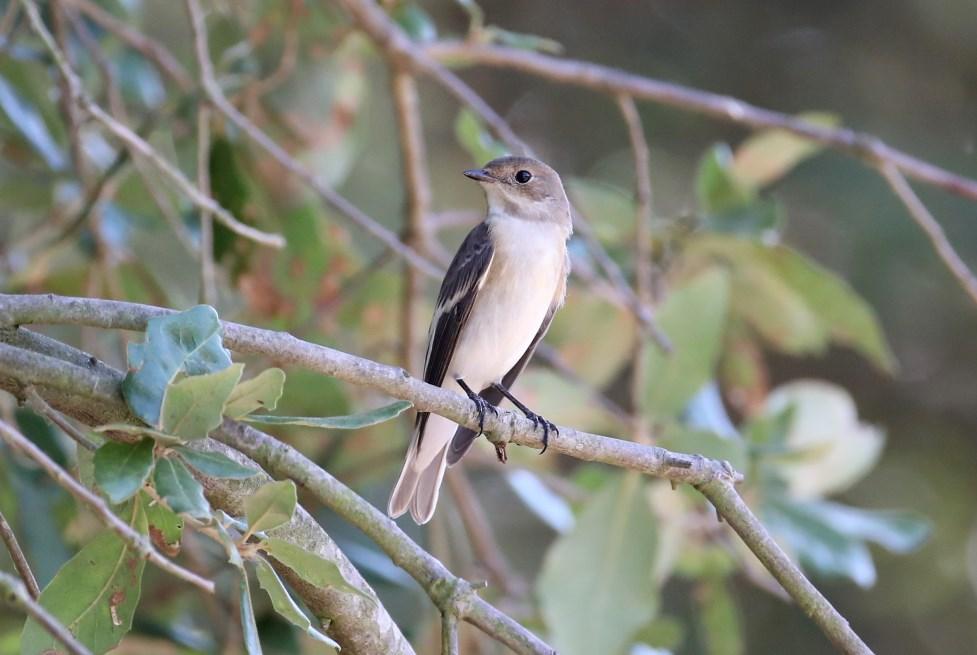
I also have a homemade MV Robinson style trap which I mostly use but seldom more than weekly. This MV works as well as the more professional shop-bought version I have on loan from Butterfly Conservation (Suffolk) but I think the latter has a better retention success than any of the other traps. My species count for home is 742 at the time of writing, although this includes a few unverified species


which would require genitalia dissection to confirm. One new species for my list was a Small phoenix (Ecliptopera silaceata).
Last year I found a yellow-spotted version of a 6spot Burnet (Zygaena filipendulae flava) for the first time but no luck this year and the population down to only about 4 or 5 compared with 30 - 40 last year, so perhaps the yellow variant springs from a good-sized colony.
First brood Common blue (Polyommatus icarus) and Brown Argus (Aricia agestis) butterflies were seen but in ones and twos, yet second brood fared much better seeing 5 male
Common blues together, 6 Brown Argus, 4 first brood Small heath (Coenonympha pamphilus) and only 1 second brood in August.
The Small heath has only recently colonised our meadow and numbers are still low but are showing signs of slightly increasing.

Small skippers did very well, and record numbers of Meadow browns were recorded. As the Meadow browns faded, the Gatekeepers and Ringlets showed, more of the former, and less of the latter. There were hundreds of Peacock caterpillars on the nettles, but a disappointing number of adults emerged from them. Small
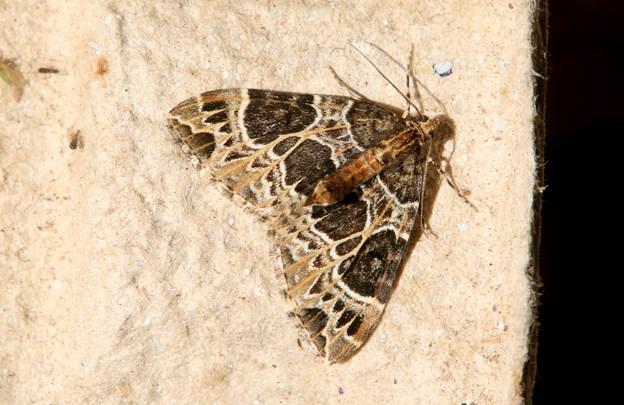
Regular observers at Landguard Bird Observatory were surprised to see a Bottle-nose Dolphin (Tursiops truncatus) feeding actively along the shipping channel for several hours on the morning of April 18th 2022. A silly amount of time has been spent staring out into the abyss seawatching at this site for over 40 years with sightings of cetaceans, apart from Porpoises, very few & far between. The number of Suffolk records of this species can be counted on less than two hands with a couple of these washed-up dead in the 1800’s (Bullion 2009). The southern North Sea is not a friendly area for dolphins due to the amount of sediment in the water and it was half expected that this one may be washed up dead somewhere along the coast in the following days. Fortunately, this was not the case so, hopefully, it swam away to a more favourable area. Around the United Kingdom the regular sites with pods of Bottle-nose Dolphin are well known and studied with many researchers knowing many individuals by name. Lone individuals are, apparently, mostly males that are known to wander more wildly but with some individuals taking up the bachelor lifestyle in pleasant surroundings for many years shunning the social lifestyle with their own kind. It is hypothesised that this individual was a wandering male going walkabout (or swim about).

This distant photo is quite probably the only individual ever photographed in Suffolk waters.
Ref: Bullion, S. (2009) The Mammals of Suffolk, Suffolk Wildlife Trust; Suffolk Naturalist’s Society.
Nigel Odin, Landguard Bird Observatory, View Point Road, Felixstowe, Suffolk, IP11 3TW
Early 2021 we were approached by the Stour Valley Farmer Cluster with regard a hedgerow project in the Dedham Vale Area of Outstanding Natural Beauty (AONB). The Cluster had received funding from the Suffolk Preservation Society (representing CPRE Suffolk) for a Hedgerow Heroes Phase 1 project, one of 5 in England. The aim being to plant and restore hedgerows in the Dedham Vale.
As hedgerows are such an important asset to the Dedham Vale’s cultural heritage, wildlife, and landscape we jumped at the opportunity to work in partnership, especially as this project would create and improve wildlife corridors across the landscape to some of our Nature Recovery Zones.

This connectivity is vital for so many species particularly for bats and dormice, our flagship species, who use hedgerows to nest, forage, and refuge. It will also reconnect isolated habitats, recreate lost landscape features, contribute to the stabilisation of soils and the flow of water on farms. All of these will result in improved soil health and water storage capacity so improving resilience for both food crops and semi-natural habitats.
The Cluster asked us whether our volunteers would be interested in surveying the hedges to help identify where the hedge work needed to be done. When I discussed how this was going to happen with Adrian Silvertown, one of our volunteers, he questioned why we were going to use pen and paper when there were good field based apps on mobile phones that could be used.
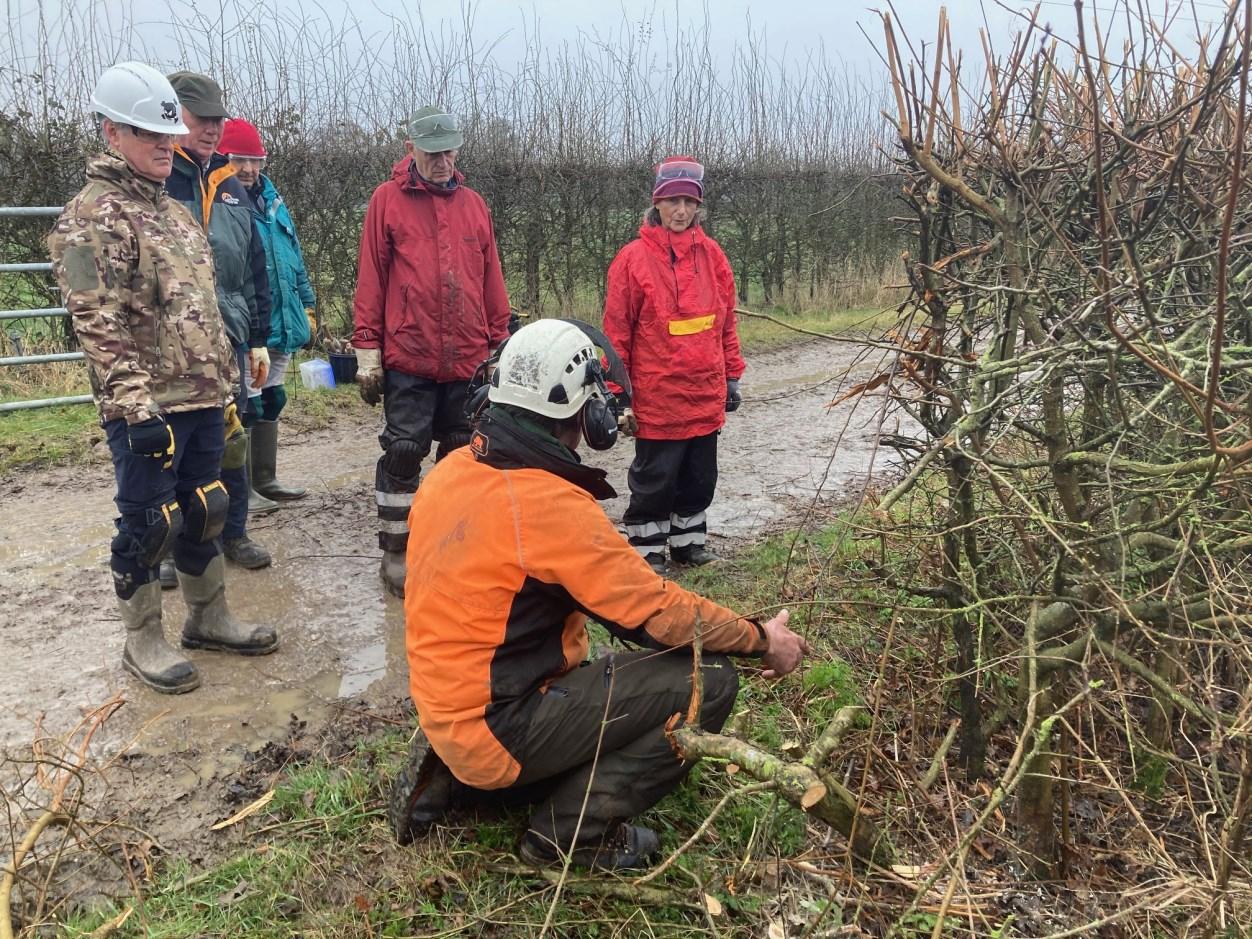
Roll forward 6 months (summer 2021) and Adrian, who has a background in technology, had created a Hedgerow Heroes App on ArcGis Survey 123. The development of this app not only facilitated the surveying of hedgerows, but it made it easier for the Cluster Facilitator to select which hedges needed to be restored /created as all the data was in one place. For his outstanding contribution in creating this app Adrian won the Dedham Vale National Landscapes Award.
Interested volunteers attended a training session to find out more about the project, hedgerow management and how to use the app in the field. They were then assigned farms in the area by the Cluster Facilitator.
Over the summer/autumn our volunteers surveyed 28km of hedgerows, assessing the quality and needs of the hedgerows, which the Cluster facilitator then used to prioritise hedgerow restoration work in the winter.
In total 4.65km of hedgerow were planted and 2.72km of hedgerow were restored by either gapping up, coppicing or conservation hedgelaying. Much of this work was done by contractors but our volunteers helped on 2 hedge planting days and 1 hedge-laying day. It was a team effort. There were 12 farms involved in the project, three farmers planted their own hedges; one contractor undertook additional planting and of course, the volunteers, five contractors worked on conservation laying and also the coppicing.

This project enabled us and our volunteers to work with farmers which has led to improved local relationships and the identification of volunteer tasks such as the removal of tree guards from historically planted hedges. People using the footpaths also commented positively on the hedgerow work.

As the Hedgerow Heroes phase 1 Project was so successful the Suffolk Preservation Society (representing CPRE Suffolk) are funding a Hedgerow Heroes Phase 2 project for 2022/3. The Project aims to do further volunteer farm surveys leading to 2km of coppicing of hedges,500m conservation hedge-laying, 3km new hedge planting and 1km gapping up.
There will also be a winter talk/farm walk on hedgerow wildlife and history, a practical workshop and demo for farmers on hedge life cycle and management, a hedge-laying taster session as well as several volunteer/youth ranger hedge planting and hedge coppicing days.

This project is a legacy project; the survey information that is collated, with the relevant landowner consent, will hopefully lead to many more kilometres of hedge being restored and created across the AONB landscape as funding becomes available.

A selection of photos from our new Facebook page

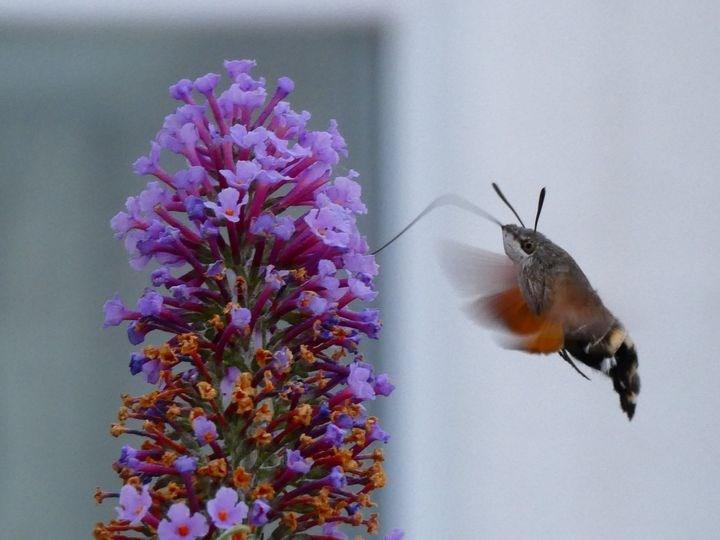
Above: Chris Cotton managed to get this wonderful photo of a Hare (Lepus europaeus) lying low
Left: Paul Gilson took this one of a Hummingbird Hawkmoth (Macroglossum stellatarum) in his garden. This summer has been a very good year for them.

Below: Pamela Pope found this Araneus marmoreus var.
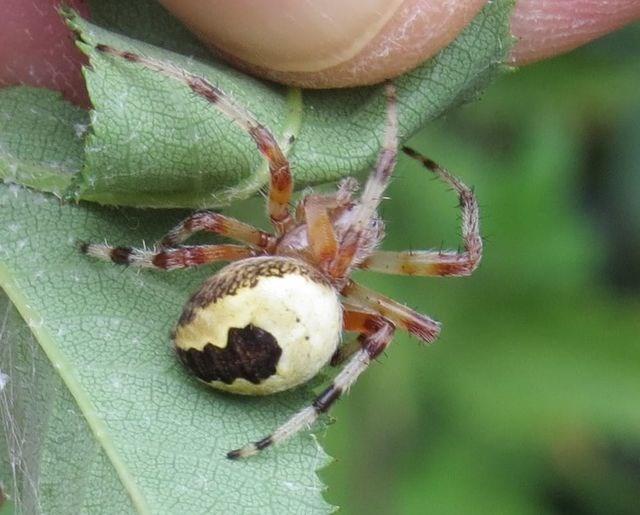
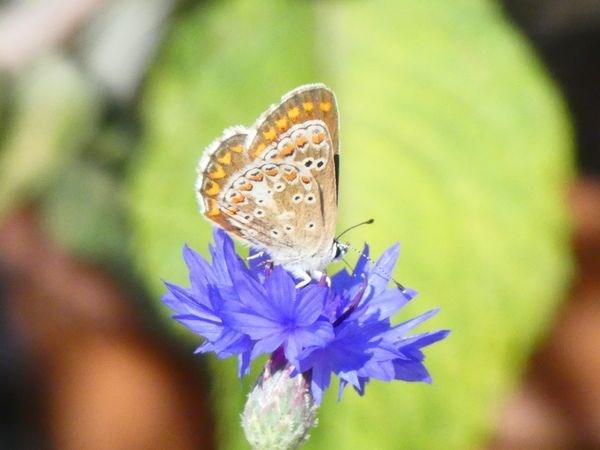




Introduction: The Chinese Water Deer (CWD) has been extensively hunted for food and exterminated as an agricultural pest in large parts of its native range. It is now restricted to the Yanche coastal wetlands, the lower regions of the Yangtze River and the islands of Zhejiang in China.
CWD were kept at London Zoo in 1873. Introductions, most notably at Woburn Park in 1896, and escapes from Whipsnade Zoo whilst the zoo was being set up in 1929, resulted in a build-up of England’s non-native population.
Range Expansion and Population Explosion: It was over a century before the CWD finally arrived in Suffolk, with records from Brandon in 1987 and Minsmere and Wangford in 1989. Solitary animals were noted at eight sites during the 1990s and, most notably, from Oulton Broad and Lound Waterworks where a significant population has since become established. From the beginning of this century, its range expanded further southwards along the coastal belt, including the first record from Orfordness in 2003. Most records referred to lone individuals, although groups of up to three were noted. Up to 2009, the species had been recorded in 25 tetrads, with one at Martlesham Creek being the furthest south.
By 2011, it had reached the Deben Estuary mouth and Felixstowe's first record came in 2017. It is now recorded regularly at most sites on the immediate coastline. There have been no sightings as yet on the Shotley Peninsula or Stour Valley, but the species has managed to 'leapfrog' into north-east Essex where it has been noted in 12 tetrads, as far south as Mersea Island.

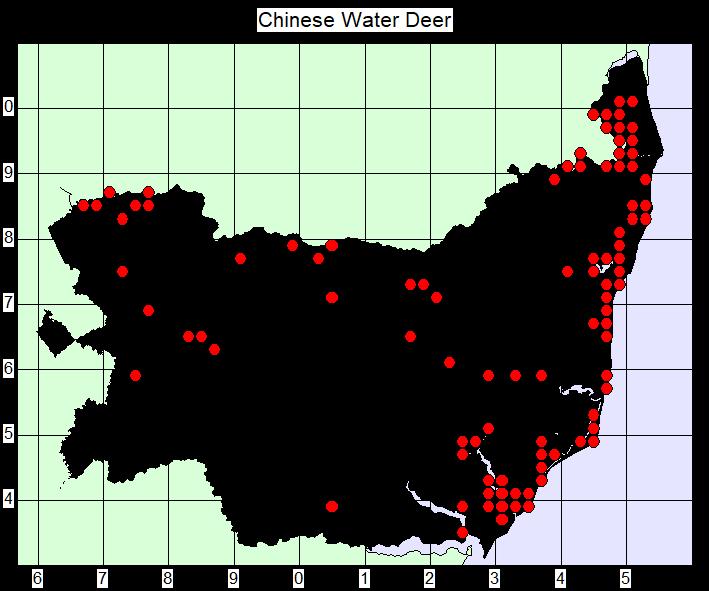
Above:
Left:

A dramatic population explosion occurred during the period 2017 to 2022 with evening gatherings of up to 50 animals being noted in the Waveney Valley and on Orfordness. To date, the highest count at Carlton was 70 in 2018 and 2019 (Andrew Easton in litt), but monitoring there has become difficult as dense vegetation stands are now established as part of the development of Peto’s Marsh from arable to the superb wetland nature reserve that can be seen today.
Fawns were first recorded on Orfordness in 2006 and the population had increased to 12 in 2008. Although not shown on the maps, CWDs are present along the main spit at Orfordness and has become a regular sight there (nine were feeding on the spit opposite Havergate Island in May 2021), occurring as far as North Weir Point, the most southerly end of the spit (Mike Marsh in litt).
A massive CWD population has grown on Orfordness and, without natural predators; numbers of this alien species continue to increase. Today, the Orfordness population is so large that other species, including rare ground-nesting birds, are at risk.

Unchecked numbers of deer can also destroy their own food sources that could result in disease and malnutrition. Reserve Managers for National Trust (NT) have undertaken habitat impact surveys across the Orfordness spit to establish the effects of over-grazing on vegetated shingle and disturbance to nesting birds by visual observations. In Nov 2021, NT commissioned a thermal drone survey to count the deer present. It showed a staggering total of c.500 animals were frequenting the Orford-
ness spit. The managers are currently in the midst a five-year plan, with an aim to reduce the deer population to a size that does not negatively impact habitats. NT understands the sensitivity of this issue and highly skilled and qualified professionals have been employed to carry out this management. A significant number of the deer will remain and the health and size of the population will continue to be monitored (Richard Gilbert in litt).
CWDs have been noted in 91 Suffolk tetrads up to September 2022. There has been a more moderate range expansion in north-west Suffolk where there are no reports of significant gatherings. South-west Suffolk is almost devoid of sightings, with one noted at Raydon Woods in December 2018 being the sole record west of the Orwell Estuary.
CWDs are prolific swimmers and have been known to swim several kilometres in one stretch, so estuarine barriers such as the Alde/Ore, Deben, Stour and Orwell presents no challenge to pioneer breeders. Ones and twos are regularly seen on Havergate Island and animals have been watched swimming across the river from the Orfordness spit. It is likely that Orfordness was colonised by deer swimming the river at low tide and the same could be the case for its expansion into north-east Essex.

Discussion: The Deer Society reports that the British population is now thought to account for 10% of the world’s total. Although two to three young is normal for this species, they can produce up to seven, so numbers can multiply very quickly.
This population explosion is a worrying trend for nature reserve managers and farmers, and control measures may be necessary in some areas. The massive gatherings on Orfordness have caused damage to the fragile habitats as the animals browse on rare lichens in winter. Reserve Managers have a responsibility to balance the deer population with an emphasis on protecting the wider biodiversity and providing a strong and healthy habitat where all wildlife can thrive. The deer has also taken a liking to wild birdseed cover plots, provided as part of Countryside Stewardship Schemes. What is a gain for the CWD will be a loss for farmland birds.

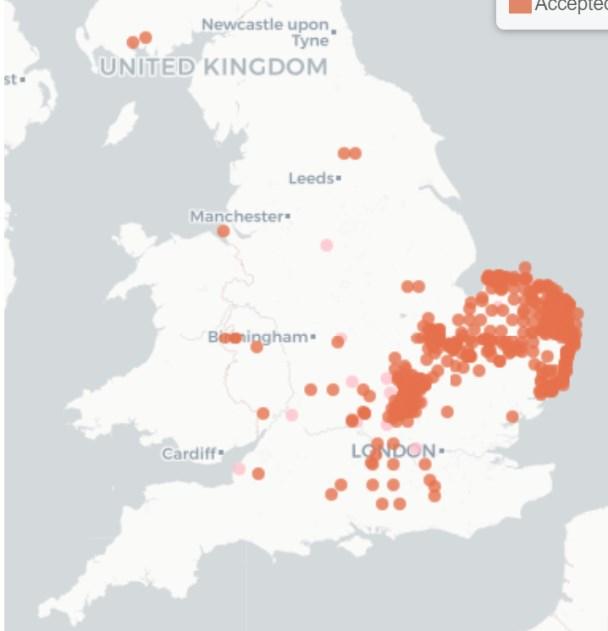
It will be interesting to monitor the effects of culls carried out by neighbouring landowners near Carlton Marshes and at Orfordness, along with those shot more widely by deer stalkers. Will the range expansion continue or will it slow down once new populations become established?
The situation regarding habitat damage and the effects on ground-nesting birds should be closely monitored. If the population continues to explode, we could have another Grey Squirrel challenge
when it may be too late to take necessary action.

Acknowledgements: Thanks are due to Richard Gilbert of National Trust for clarifying management strategy and objectives on Orfordness, Andrew Easton and Mike Marsh for additional observations and John Grant and Matt Gooch for their comments on the draft. Martin Sanford (Suffolk Biological Information Service) supplied the maps and records, and photographs were kindly contributed by Andrew Easton and Dave Crawshaw as credited.
Reference:
Bullion, S. 2009. The Mammals of Suffolk. Suffolk Wildlife Trust and Suffolk Naturalists’ Society. Ipswich.
Have you ever noticed how many common English names for plants share their names with animals. I’m sure we are all familiar with the orchids that take their names from the animals that they are either thought to resemble or possibly be pollinated by, such as the Bee Orchid (Ophrys apifera), Early Spider-orchid (O. sphegodes), Fly Orchid (O. insectifera) and Lizard Orchid (Himantoglossum hircinum), with the central lobe of its labellum resembling the long tongue of a lizard.

There are several references to birds, with the seeds of Bird’s-foot (Ornithopus perpusillus) and Bird’s-foot-trefoil (Lotus corniculatus) looking like the claws on a bird’s foot, the central yellow spot in Bird’s-eye Primrose (Primula farinosa) considered by Gerard to resemble the eye of a bird and the roots of Bird’s-nest Orchid (Neottia nidus-avis) thought to look like the dense interwoven parts of a bird’s nest. But why Bird Cherry and Bird-in-a-bush? Other references to specific bird species include Crane’s-bills (Geranium sp.) and Stork’s-bills (Erodium sp.), which reference the shape of the seed pod, Cuckooflower (Cardamine pratensis), because it flowers at the same time as the cuckoo sings, and Goosefoots (Chenopodium sp.), because the leaves are similar to the footprint of a Goose. The English name Hawkbit (Leontodon sp.)
derives from the medieval belief that hawks ate the plant to improve their eyesight. Finally, Larkspur (Consolida sp.) has a long corolla tube that takes the shape of the spur, or long hind claw, on the foot of a lark.

Cats and dogs, especially in their colloquial forms, feature highly on the list. Catmint (Nepeta sp.), a plant that cats show a liking for, Cat’s-tail (like Squirrel-tail and Rat’s-tail Fescues and Dog’s-tail, Mare’s-tail and Mouse-tail), where the inflorescence looks like a tail and Cat’s-ear (like Mouse-ear) for the fine hairs on the leaves. The word ‘dog’ is often use in a herbal sense to mean ‘inferior’, so Dog’s Mercury was considered inferior to Annual Mercury for use as an enema, Dog-violets were inferior to Sweet Violets because they lacked scent and the Dog Rose wasn’t as striking as the Garden Roses (although I might disagree on that one). Dogwood, whilst having beautiful foliage in the autumn, wasn’t considered a worthwhile plant – its fruits aren’t edible, it has an unpleasant odour and its timber had few practical uses. However, Dog’s-tooth Violet is again named for its appearance with the oblong white bulb resembling a dog’s tooth.
Some other plants named after the parts of animals because of their similarity are the grasses Cock’s-foot and Cockspur, where the shape is referring to the inflorescence, Adder’stongue with the erect sporangia nestling within the leaf blade having the appearance

of a tongue and Weasel’s-snout, where the pink flowers resemble a miniature snapdragon and are followed by a hairy green fruit which is said to resemble a weasel’s snout (you may need to use your imagination here). The Dandelion takes its name for the French Dent de lion or tooth of the lion referring to the jagged shape of the leaves.
The common name Cowslip may derive from the old English for cow dung, probably because the plant was often found growing amongst the manure in cow pastures. Similarly Oxlip, although this is more likely to be in wood pasture.
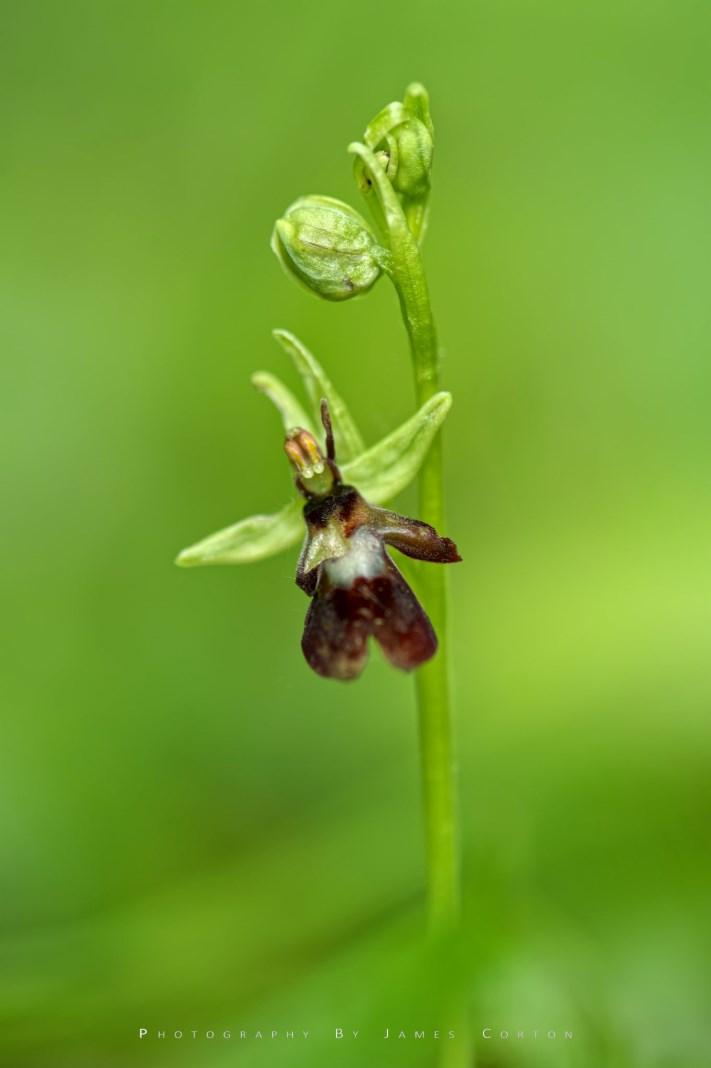
Some are a little more obscure and possibly requiring a little more imagination. The common name of Fox-and-cubs, which has often intrigued me, is apparently due to the appearance of the open flowers (the fox) beside the flower buds (the cubs).
I’m sure you can think of many more examples. So a challenge - to find as many names as you can that are associated with animals and try to work out their derivation.

Maybe you would like to write something for a future magazine. It is a fascinating subject that requires further research. Over to you.
This is a review of the larger Ichneumonid Wasps that I have found in my Felixstowe garden during 2020 and 2021.In total there are an incredible 2500 plus species that have been recorded within the British Isles. This is roughly 10% of all known British insect species When I first started to look at these amazing insects it became all too quickly apparent how little was known about individual species and indeed how difficult they are to identify. It really has been an intense but enjoyable learning curve. I will be the first to admit that without the help of experts (see acknowledgements) in this field a vast majority of the species that follow would have been misidentified to such a degree, even to ‘tribe’ that it would have been embarrassing.
Apart from the experts in this field along with a few amateur naturalists there are very few studies of these insects undertaken and though it seems relatively pointless to quote distribution data but I have included the number of records accepted on NBN atlas as a guide. These only go to highlight how little is known about this fascinating group of insects.
Recorded on the 22nd and 24th August 2020. One of the Heresiarchini tribe and one of the larger Ichneumonids with its body length between 20-25mm. The only Ichneumonid known to parasitise pupae of the Large Elephant Hawk Moth (Deilepila elpenor). Eggs are laid in the caterpillar from which the adult emerges. The NBN atlas quotes only 18 records to date for Britain but as its host species is a relatively common moth this species must surely be under-recorded.



Only recorded in 2021 when noted as present almost daily from 3rd June through to at least the 11th July. Parasitises the pupae of mainly the larger Noctuidae and Notodontidae moths with the Large Yellow Underwing (Noctua pronuda) appearing to be a favourite host.
NBN atlas has 268 records scattered across Britain. A cosmopolitan species which is present in the temperate zones across the globe including much of Europe and the Near East, Oriental and Nearctic regions.
Ctenichneumon panzeri
Only recorded in 2021 on the 27th June when this female was present.
Parasitises various Noctuidae Moth pupae Surprisingly the NBN atlas quotes only six records of what is a widespread European species with its range extending to North Africa and across to central Asia and Pakistan.

Ichneumon stramentor
Recorded in both 2020 and 2021 with extreme dates been 12th May to the 14th June.
Parasitises both Moth and Butterfly larvae/pupae.
Recorded in Britain up to the Scottish boarders. Status in Europe appears to be widespread in the Low Country’s with a thin scattering else-where with records as far south as southern Spain and east to central European Russia.
Ichneumon
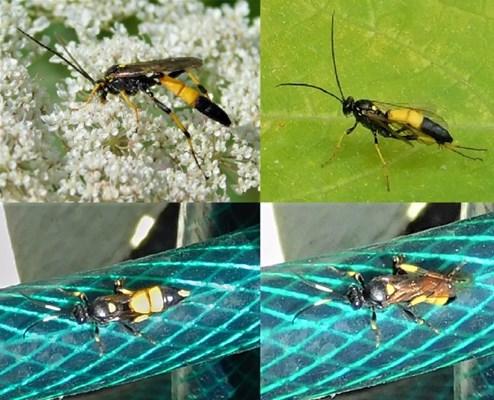
Recorded in both 2020 and 2021 with extreme dates been 12th May to the 14th June. Parasitises both Moth and Butterfly larvae/pupae.
Recorded in Britain up to the Scottish boarders. Status in Europe appears to be widespread in the Low Country’s with a thin scattering else-where with records as far south as southern Spain and east to central European Russia.
Ichneumon xanthorius
Recorded in both 2020 and 2021 with extreme dates been 12th May to the 14th June.
Parasitises both Moth and Butterfly larvae/ pupae.
Recorded in Britain up to the Scottish boarders. Status in Europe appears to be widespread in the Low Country’s with a thin scattering else-where with records as far south as southern Spain and east to central European Russia
Ichneumon sarcitorius

Only one record of the photographed male on the 9th July 2021. Known host Moths include the Turnip Moth (Agrotis segetum), the Gypsy Moth (Lymantria dispar) and the White Ermine (Spilososoma lubricpeda).

British status. NBN quotes 123 records mostly in southern England, the Midlands and the north east with a small scattering of sightings from Scotland and Northern Ireland. Though this species is basically European there are seven sub-species listed with isolated records from as far afield as Alaska, the Azores and Korea.
Stenichneumon culpator

Left and below: A female. Recorded on the 2nd and 4th September 2021.

There are three very similar species that have been recorded in Britain, however the tooth like tubercle on the ventral side of the hind coxae seen in the photo to the left is diagnostic for this species.
NBN atlas quotes 39 records with the majority in the central Midlands. There are however three accepted records for Scotland. European status is based around the Low Country’s as well as southern Scandinavia and Baltic coast countries. Also present around the Great Lakes in both Canada and the USA.
The only record was of this female on the 23rd June 2021.

NBN atlas shows only 20 records scattered across the Country north to just past Leeds. A cosmopolitan species with records centred in and around the Low Countries in Europe with other records from southern Scandinavia, Greenland (?) and
Recorded on three dates from 11th August to 15th which are likely to involve the same individual.
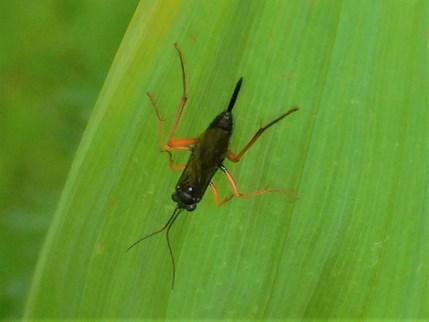
NBN atlas has 220 records which are centred in the Midlands, the Bristol area and east south Wales. A European species with the population mainly in the Low Countries, central Europe and the southern Baltic. Isolated records from the Canary Islands and Tunisia.
Acknowledgements.
My thanks to Gavin Broad and Jaswinder Boparai who’s identification skills, patience and help over the past couple of years have meant that I’m actually (perhaps) getting to grips with this fascinating group of insects.
References
Broad.G, Shaw. M, and Fitton. M. Ichneumonid Wasps, there Classification and Biology.
Brock. P, Britain’s Insects. A field guide to the insects of Great Britain and Ireland.
The SNS 2023 conference Into the Wild will look at different aspects of the rewilding debate. We are delighted to announce that we have the following confirmed speakers and look forward to welcoming members and non-members to this exciting, topical event:
Prof. Alistair Driver - Director, Rewilding Britain and Honorary Professor in Applied Environmental Management, University of Exeter
Tony Juniper - Chair, Natural England
Prof. William Sutherland - Miriam Rothschild Professor of Conservation Biology, University of Cambridge and President, British Ecological Society
Matt Gooch - North East Sites Manager, SWT
Dr Keith Kirby - Visiting Researcher, University of Oxford
Dr Tim Gardiner - Biodiversity Officer, Environment Agency
Dr Kim Ward - Lecturer Human Geography, University of Plymouth
Archie Ruggles-Brise - Landowner and Independent Environmental Consultant
John Sanderson - Farmer (Suffolk)
Prof James Bullock - Scientist, UK Centre for Ecology & Hydrology and Visiting Professor Southampton, Liverpool & Bournemouth Universities
Jake Fiennes - Conservation Director, Holkham Hall Estate (Norfolk)
The conference will be held online on two half days, Saturday 4th March and Saturday 11th March 2023, with opportunities to ask questions and a small admission fee. Everyone welcome!”



The Suffolk Naturalists’ Society offers six bursaries, of up to £500 each, annually. Larger projects may be eligible for grants of over £500 – please contact SNS for further information.
Activities eligible for funding include: travel and subsistence for field work, visits to scientific institutions, scientific equipment, identification guide books or other items relevant to the study.
Morley Bursary - Studies involving insects (or other invertebrates) other than butterflies and moths.
Chipperfield Bursary - Studies involving butterflies or moths.
Cranbrook Bursary - Studies involving mammals or birds.
Rivis Bursary - Studies of the county's flora.
Simpson Bursary - In memory of Francis Simpson. The bursary will be awarded for a botanical study where possible.
Nash Bursary - Studies involving beetles.
Applications should be set in the context of a research question i.e. a clear statement of what the problem is and how the applicant plans to tackle it.
Criteria:
1. Projects should include a large element of original work and further knowledge of Suffolk’s flora, fauna or geology.
2. A written account of the project is required within 12 months of receipt of a bursary. This should be in a form suitable for publication in one of the Society's journals: Suffolk Natural History, Suffolk Birds or White Admiral.
3. Suffolk Naturalists' Society should be acknowledged in all publicity associated with the project and in any publications emanating from the project.
Applications may be made at any time. Please apply to SNS for an application form or visit our website for more details www.sns.org.uk/pages/bursary.shtml.

The Suffolk Naturalists’ Society, founded in 1929 by Claude Morley (1874 -1951), pioneered the study and recording of the County’s flora, fauna and geology. It is the seed bed from which have grown other important wildlife organisations in Suffolk, such as Suffolk Wildlife Trust (SWT) and Suffolk Bird Group (SBG).
Recording the natural history of Suffolk is still the Society’s primary objective. Members’ observations go to specialist recorders and then on to the Suffolk Biodiversity Service at The Hold to provide a basis for detailed distribution maps and subsequent analysis with benefits to environmental protection.
Funds held by the Society allow it to offer substantial grants for wildlife studies.
Annually, SNS publishes its transactions Suffolk Natural History, containing studies on the County’s wildlife, plus the County bird report, Suffolk Birds (compiled by SBG). The newsletter White Admiral, with comment and observations, appears three times a year. SNS organises two members’ evenings a year and a conference every two years.
Subscriptions to SNS: Individual membership £15; Family/Household membership £17; Student membership £10; Corporate membership £17. Members receive the three publications above.
Joint subscriptions to SNS and SBG: Individual membership £30; Family/Household membership £35; Student membership £18. Joint members receive, in addition to the above, the SBG newsletter TheHarrier.
As defined by the Constitution of this Society its objectives shall be:
2.1 To study and record the fauna, flora and geology of the County
2.2 To publish a Transactions and Proceedings and a Bird Report. These shall be free to members except those whose annual subscriptions are in arrears.
2.3 To liaise with other natural history societies and conservation bodies in the County
2.4 To promote interest in natural history and the activities of the Society.
For more details about the Suffolk Naturalists’ Society contact:
Hon. Secretary, Suffolk Naturalists’ Society, The Hold, 131 Fore St, Ipswich IP4 1LR. enquiry@sns.org.uk